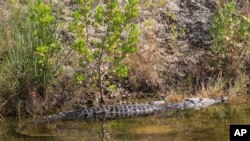A World Wildlife Conference is wrapping up Wednesday, after adopting dozens of resolutions aimed at protecting some of the reported 1 million animal and plant species threatened with extinction.
CITES, the Convention on International Trade in Endangered Species of Wild Fauna and Flora, also has revised the trade rules for dozens of wildlife species whose sustainability is threatened by overharvesting, overfishing or overhunting, and has expanded the capacity to fight illegal trade.
CITES Secretary-General Ivonne Higuero said illegal traders remain a threat, and praised the actions taken by representatives at the conference to combat the growing menace posed by the rapid pace with which wildlife crime is moving online.
"For example, you adopted decisions on strengthening enforcement efforts for tortoises and freshwater turtles," she said. "You will also support efforts to tackle illegal trade in the sub-regions of West and Central Africa. This illegal trade affects elephant ivory and species such as pangolins, parrots and rosewood. Another important decision was to establish the CITES Big Cat Task Force."
The mandate of that task force, she said, is to improve enforcement, tackle illegal trade and promote collaboration on conserving tigers, lions, cheetahs, jaguars and leopards. The illegal trade in wildlife is estimated to be worth up to $20 billion a year.
Higuero said more needs to be done to assist countries in strengthening their criminal justice systems, adding that more vigorous action will have to be taken to combat wildlife crime linked to the internet.
"I am pleased to note that CITES has now started to open a new digital front, both to more effectively regulate legal trade and to combat illegal trade," she said. "This will lead to more efficient border controls using modern technology-based approaches, such as electronic risk management and targeted inspections."
CITES noted that vicuna populations in Bolivia, Peru and parts of Argentina have been revived through sustainable use. As a result, the conference downlisted a regional vicuna population in Argentina to permit sustainable trade, instead of banning all commercial trade in the species.
The recovery of the American crocodile population of Mexico, which is seen as another conservation success, has been similarly downlisted.










